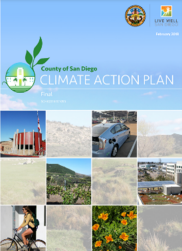2018 CLIMATE ACTION PLAN
The 2018 Climate Action Plan (CAP), adopted on February 14, 2018, outlines 11 strategies and 26 measures to meet the State’s 2020 and 2030 greenhouse gas (GHG) emissions targets while progressing toward the 2050 GHG reduction goal.
On September 30, 2020, the County Board voted to set aside its approval of the County’s 2018 CAP and related actions because the Final Supplemental Environmental Impact Report (2018 CAP SEIR) was found to be out of compliance with the California Environmental Quality Act (CEQA). The court ruling did not find fault with the 2018 CAP’s 26 GHG reduction measures, and the County continued implementing the sustainability measures to reduce emissions while addressing the legal deficiencies in the plan.
The 2024 CAP, adopted on September 11, 2024, replaces the 2018
CAP as the County's comprehensive framework for reducing GHG
emissions. This updated plan resolves the issues identified in the
2018 CAP’s SEIR. Developed in partnership with residents,
businesses, and environmental groups, the 2024 CAP reaffirms the
County’s commitment to sustainability while refining its approach to
achieving long-term environmental goals. The County will continue to
monitor and report on the implementation
progress of the 2018 CAP measures through the end of 2024.
2018 CAP PROJECT DOCUMENTS AND TECHNICAL REPORTS
Final County of San Diego 2018 Climate Action Plan
Final County of San Diego 2018 Climate Action Plan Appendices:
- Appendix A: 2014 Greenhouse Gas Emissions Inventory and Projections
- Appendix B: County Operations Greenhouse Gas Emissions Inventory and Projections
- Appendix C: Greenhouse Gas Emissions Reduction Targets, Measures, and Gap Analysis
- Appendix D: Climate Change Vulnerability Assessment
- Appendix E: Public Outreach and Engagement Plan
- Appendix F: General Plan Policies Crosswalk Table
Final Supplemental Environmental Impact Report (including Appendices, Findings, and Mitigation Monitoring and Reporting Program) - located at the link below.
- Climate Action Plan Consistency Review Checklist
- General Plan Amendment for the Climate Action Plan
- Guidelines for Determining Significance for Climate Change
- Report Format and Content Requirements for Climate Change
- Climate Action Plan Implementation Cost Report
- Climate Action Plan Cost-Effectiveness Analysis
- Preliminary Assessment of the County of San Diego Local Direct Investment Program
Click here to access the Final Supplemental Environmental Impact Report.





